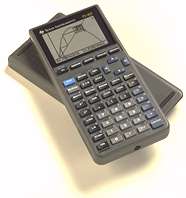
| Iteration and Staircase Diagrams on a TI-82 |  |
The "cobweb diagram" on the screen of the TI-82 pictured above is a variant of the "staircase diagrams" we have used to find square roots. TI's reference manual explains how this feature can be used to illustrate phenomena associated with chaos (see Chapter III of IADM). However, this feature can also be used to enrich the standard algebra curriculum - e.g., in the solution of polynomial equations.
To implement the iterative procedure we have used to find the square root of two:
Press the MODE key and, in the fourth line, highlight Seq (for the "sequence mode").
Press the Y= key and (using 2nd 7) enter
Press the WINDOW key and, in the first line, specify a starting value of u1 = 4.
Press 2ndGRAPH (TABLE) to get a tabular representation of the iterative process.
To generate the staircase diagram corresponding to this iterative procedure:
Press the WINDOW key and set Xmin=0, Xmax=5, Ymin=0, and Ymax=4. Returning to the top of this menu, move right to FORMAT and, in the first line, highlight WEB.
Press the GRAPH key t o obtain a graph of y = F(x) and of y = x.
Press the TRACE key followed by repeated "right buttons" to generate the staircase diagram, one segment at a time.
Chapter I of IADM goes on to show how this procedure can be adapted to the solution of quadratic and cubic equations as well.
The TI-83 is very similar, with one exception: There is no single keystroke for entering "u(n-1)." Instead, 2nd-7 enters a "u" and the "independent variable key" enables one to enter "n".
Exercise. Use a TI-82 or TI-83 to create "a square root machine." This can be done by introducing k as a variable (initially set at k = 2) and modifying the iterative scheme accordingly.